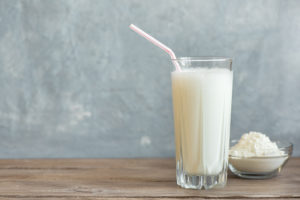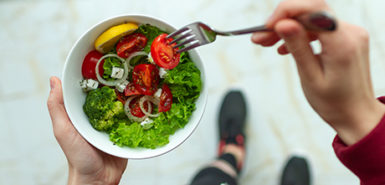
Protein shake. Meal replacement shake.
Any difference? Are they healthy? Will they help with weight loss? Improve athletic performance?
It’s all a little confusing.
Spectrum Heath dietitian Caren Dobreff is here to help.
How much protein do I need?
Protein supports everything from muscle maintenance to basic body functions.
“If the body doesn’t get enough calories or energy on a regular basis from dietary carbs, fats and proteins in food, it can look to reserve sources such as breaking down muscle to get what it needs,” Dobreff said.
The recommended daily amount of protein is 0.8 grams per kilogram of body weight.
Calculate how much you need: Divide your weight in pounds by 2.2, then multiply that by 0.8. This gives you the number of grams you need each day.
“Sometimes the body may require more protein to meet needs,” Dobreff said.
This can happen during times of illness or injury, or when you’re exercising or lifting weights. In such instances, the body processes protein at a faster rate for longer periods of time, Dobreff said.
Are food sources adequate to fulfill protein needs?
Typically, yes. Protein comes from many foods—dairy, meat, eggs and fish. If you’re looking for plant sources, you can find it in nuts, seeds, beans, legumes and whole grains.
Most people get enough protein—maybe even too much—each day from the food they eat, Dobreff said.
Are protein shakes and meal replacement shakes the same thing?
In short, no. There’s a difference, Dobreff explained.
Protein shakes provide calories, primarily protein, in varying amounts from various sources. Generally, a protein shake can provide the equivalent of a protein serving you’d get from a meal—anywhere from 14 to 28 grams.
Meal replacement shakes, on the other hand, provide calories from protein and other sources, such as carbohydrates and fats.
“Basically, it’s taking a meal’s worth of calories and putting it into a blended form,” she said.
Meal replacement shakes have less protein—typically less than 14 grams—because they’re also providing calories from other sources.
“Don’t get caught up with the marketing and packaging,” Dobreff said. “Flip it over. Go to the nutritional table and look at the number of calories and the grams of carbs and protein and fat.”
When might I opt for a shake?
Protein shakes can be helpful for people who are short on protein intake, or those who find it difficult to consume enough food to meet their protein needs at that time.
A high-performing athlete is a good example.
In some cases, a health care professional may also have a patient consume more protein than usual—sometimes as much as 50% more than the recommended daily allowance.
“A healthy, balanced diet would probably not need protein shakes to meet daily nutrition needs, as all the essential nutrients would be consumed in a healthy, real food diet,” Dobreff said. “Having said that, protein shakes can fit and be part of a healthy, balanced diet.”
Like when?
“When busy schedules lead to meal skipping or (they) don’t support making or eating a healthy meal or snack,” she said.
Meal replacement shakes work best when they’re part of a healthy, balanced diet. They can be used as an occasional meal replacement.
“Think of all the nutrients the body needs and uses daily,” Dobreff said. “That’s a lot of responsibility to put in a shake.”
She suggests keeping some on hand for those times when your schedule might keep you from preparing a healthy meal.
A warning: If shakes are your sole source of nutrients, it’s possible the overall calorie and protein intake can be too restrictive, Dobreff said. This could slow the body’s metabolism.
That could lead to weight gain instead of weight loss.
What should I look for on a protein shake label?
As with all products, look for natural, wholesome ingredients that you recognize, Dobreff said. Look for ingredients you can pronounce.
“Some companies make their all-natural supplement drinks with soy milk, Greek yogurt or nut milk that taste great and are all natural,” she said. “These products would not only help meet protein needs but come with good fats, antioxidants, fiber, vitamins and minerals.”
When possible, avoid artificial sweeteners, artificial colors and preservatives.
“There are so many products on the market today that offer natural, fake-free ingredients,” Dobreff said. “They are easy to find. Or better yet, make your own.”
Along the way, be mindful of your personal health and nutrition needs.
A person with diabetes should carefully consider the amount of carbs or sugar in a protein shake. If you have food allergies, find a product that works for you.
And if you do have a protein shake, make sure you don’t drink it too fast or all at once—you might end up with nausea or an upset stomach. High-protein foods consumed quickly can be demanding to digest.
“It’s best to consume them slowly and as part of a meal with other foods that provide carbs, fiber and good fats such as whole fruit, avocado or nut butters,” Dobreff said.
 /a>
/a>
 /a>
/a>
 /a>
/a>